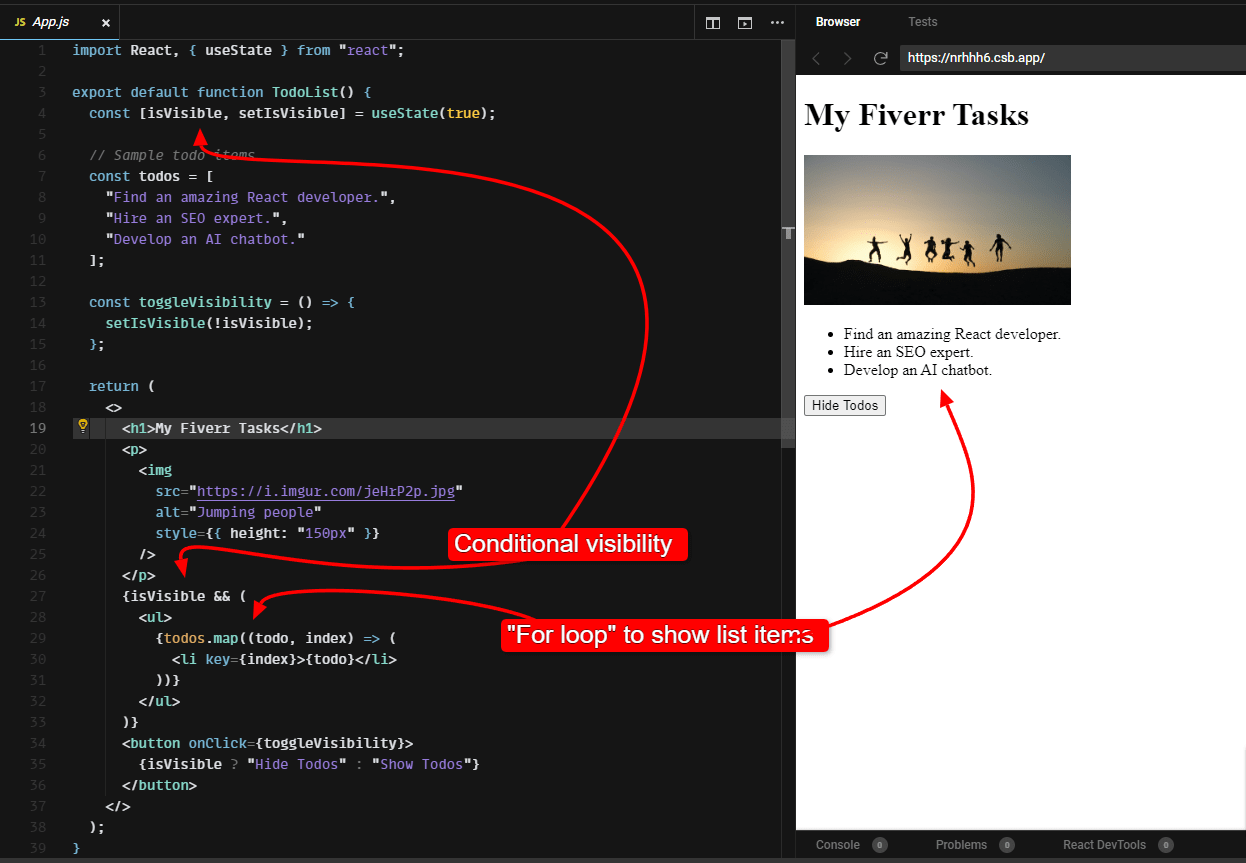jQuery vs. React: 2024 Differences and Why to Choose One Over the Other
These two enormously popular JavaScript libraries serve different purposes.
 November 11, 2023
November 11, 2023 8 minute reading
8 minute reading
jQuery and React are the two most popular JavaScript libraries for front-end development in the world, according to Stack Overflow’s latest Global Developer Survey. However, jQuery’s popularity is more substantial among professional developers than among those getting started with coding.
New coders likely prefer React because jQuery emerged in an era before many of the significant advancements in web development occurred. This puts jQuery at a disadvantage in specific projects requiring modern features.
But whether to choose jQuery or React isn’t so easy to answer.
Let’s take a deep dive into the background and use cases of these popular JavaScript libraries so you can decide which is best for you.
An overview of jQuery and React
Facebook introduced React in 2009 as a front-end JavaScript framework to alleviate many of the challenges that front-end developers were experiencing in those days. It was hoped that React would greatly simplify the development of single-page applications, or SPAs.
jQuery is an older utility library that provides quick solutions for simple problems. Whereas React is a framework dedicated to building user interfaces quickly, jQuery serves more as an all-around Swiss Army knife toolkit that helps make JavaScript developers’ lives easier.
JavaScript is much easier to work with today, especially since ECMA International—the body regulating JavaScript standards—released ECMAScript 6, the 2015 standard for JavaScript, commonly known as EC6.
EC6 introduced fundamental changes to JavaScript that reduced the need for many of the solutions provided by jQuery. However, a vibrant ecosystem and a plethora of third-party libraries had arisen by then, cementing jQuery’s position as an integral part of many web applications.
jQuery also offers sophisticated and intuitive extension methods to query the DOM (Document Object Model) that JavaScript lacks, further ensuring that JavaScript developers continue to use jQuery.
Unfortunately, React and jQuery don’t work seamlessly together. Although it’s possible to use React and jQuery in the same project through workarounds and careful planning, it isn’t recommended. Developers typically use jQuery and React in the same codebase only when an exceptional reason exists, such as a large legacy codebase that needs to be maintained.
Because React and jQuery serve entirely different purposes, choosing either depends specifically on the objectives of your project.
Popular front-end JavaScript frameworks such as React, Vue, and Angular have rendered many of the original reasons for choosing jQuery obsolete.
For straightforward web pages or web apps, jQuery remains an excellent choice, especially if you don’t have extensive experience with any of the above front-end frameworks.
React typically makes more sense for large-scale applications.
Different purposes
jQuery was developed as a fast, small, feature-rich JavaScript library, primarily designed to simplify tasks like HTML document traversal, manipulation, event handling, and animation.
For example, jQuery lets JavaScript developers execute many complex tasks in a single line of code. The following JavaScript code sample to change the CSS of all paragraphs in an HTML document requires a mind-boggling 33 lines of code.

JavaScript code sample to animate a paragraph’s opacity.
Achieving the same result using the jQuery library requires only a single, intuitive line of code:

Single line of code in jQuery.
Converting that single line of jQuery code into React wouldn’t be a fair comparison. Yes, the resulting code in React is more complex. But the comparison is moot: CSS standards have advanced so much since the release of jQuery that we can now achieve the same result without using any code.
Specifically, the ability to add fade-ins was added directly to the CSS standard in 2009. Browser support for CSS transitions and animations lagged, but all major browsers supported it a few years later. Programmers no longer needed to use JavaScript code to create fade-ins but could simply add the relevant CSS, and the browser took care of the rest:
jQuery was designed to solve challenges that developers were experiencing, but many of those challenges no longer exist, because technology has advanced.
Facebook created React primarily to facilitate building user interfaces, especially complex ones that provide an excellent user experience. Getting to the point of generating simple animations in React requires that you scaffold the basic React app first. That takes some initial work. Once the scaffold exists, React lets you do many more complex things easily that jQuery can’t.
The rule of thumb could be:
For quick JavaScript solutions in existing projects, use jQuery, because of its ease of use.
For building an entire app from scratch, especially large applications, consider using React.
DOM manipulation
React uses a virtual DOM, while jQuery works with the traditional DOM. Both choices have pros and cons.
React’s preference for a virtual DOM is also a significant difference between React and Angular—Google’s open-source front-end framework.
The React library carries out all DOM element tasks in memory. When those tasks are complete, it pushes the changes to the physical DOM. Working with the real DOM, changing an element means changing the physical structure for every step, leading to potentially slower code.
Community and ecosystem
React has a rich ecosystem of React libraries to speed up development. It also has a far greater number of npm packages than jQuery. However, that doesn’t necessarily mean that jQuery has fewer third-party libraries to support it.
jQuery predates the widespread adoption of npm—the Node Package Manager, a package manager used to install and manage software packages or libraries used in JavaScript development.
Extending jQuery functionality is typically done by adding jQuery plug-ins through an additional <script> tag in the code, and usually a stylesheet tag as well.

Necessary tags to include the jQuery UI plug-in in a jQuery project.
React is tightly integrated with npm because it depends heavily on Node.js tooling. You can install all the necessary dependencies required to make your React project work using npm commands.
For example, to add a UI elements framework to your React project, such as the Material UI framework, you’d use the following npm command:
npm install @material-ui/core
Syntax
Both jQuery and React follow JavaScript syntax but use different internal frameworks to interact with the DOM. jQuery employs native JavaScript methods directly, while React uses its own set of methods and structures to manage the DOM. This leads to fundamental differences in how you write code for each.
Additionally, React uses JSX, an XML-like syntax extension for JavaScript to reduce complexity when creating user interfaces.
HTML, CSS, and JavaScript work together to create interfaces across the web. Their code usually sits in different files. JSX allows you to combine HTML-like and JavaScript code in a single file, making creating reusable, component-based UIs easier.
JSX brings a similar integrative syntax to front-end development that was previously available only in server-side languages such as PHP. Using JSX, you can integrate logic from the JavaScript programming language directly into the HTML.
The following JSX code sample demonstrates how we’ve integrated programming logic directly into the HTML, similar to how PHP programmers are accustomed to doing.

Example of a JSX file.
If you’re interested in learning JSX, you can buy online coding lessons from Fiverr freelancers to help you.
Mobile web apps
It’s important to differentiate between React.js (“React”) and React Native. Although React Native and React share many similarities, including a common syntax, React Native was explicitly designed to create native mobile apps that run directly on a device. On the other hand, React.js creates websites or web apps.
jQuery doesn’t have a comparable software development cousin for creating native mobile applications, so we’ll only compare each library’s ability to create mobile web apps.
React’s component-based architecture empowers React developers to build UIs in a highly modular fashion, which significantly aids in developing mobile-friendly web apps. React’s virtual DOM also provides a significant performance advantage on mobile devices over jQuery.
React’s architecture lends itself to creating progressive web apps (PWAs), which can offer near-native experiences on mobile browsers. React also has a rich ecosystem of third-party libraries and tools optimized for mobile web, like React Router for navigation and various UI libraries tailored for mobile interfaces.
Using jQuery to create PWAs is far more challenging and not recommended. jQuery comes from an era before PWA. The best that jQuery can offer is jQuery Mobile, a library that allows developers to create jQuery web pages that respond to touch input.
If you have a website built mostly in jQuery and want to create a PWA or mobile app, buying JavaScript development services from Fiverr freelancers might be more cost-efficient to recreate the app in React.
Learning curve
jQuery’s learning curve is much smoother than React’s for two reasons:
You don’t need to learn all of jQuery to use it effectively for simple tasks.
jQuery was designed as a lightweight plug-in to streamline common JavaScript tasks, making it easier to grasp without delving into more complex architectural concepts.
However, the learning curve matches jQuery’s capabilities—you’ll quickly hit a ceiling for complex applications. Using jQuery, you’ll be able to easily add functionality to an existing web page, but you’ll be limited when creating a more robust web app that can scale.
React’s learning curve is steeper because you have to become familiar with new concepts, such as:
JSX
Component life cycles
State management
Node.js
npm
The additional investment of time has a better chance of paying off. Many of the concepts are common to other popular JavaScript frameworks, such as Angular and Vue.
Although React, Vue, and Angular are quite different in themselves, they all emerged in a newer era than jQuery, and so they share many similarities.
jQuery’s compatibility with any of these frameworks is another problematic issue. Even Bootstrap, a framework that supported jQuery for years, has shifted away from jQuery to vanilla JavaScript. So, anyone choosing to learn jQuery will be learning it for itself, not for use with any of these frameworks.
If you intend to work on legacy projects, your skills as a jQuery developer will be welcome and probably well-remunerated. But if you’re looking for a longer career that matches the demands of a modern web, investing your learning time in React makes far more sense.
SEO
In the early days of React and other front-end JavaScript frameworks, SEO issues were common. Google wasn’t able to crawl websites with heavy front-end JavaScript, requiring software developers to create numerous workarounds to help Google crawl their site. The problem was especially troublesome for complex applications, and one common solution was to enable server-side rendering (SSR), which has pros and cons.
jQuery doesn’t offer server-side rendering, but Google is now perfectly able to crawl JavaScript-heavy sites. Today, Google even provides an official JavaScript SEO guide about developing a JavaScript-heavy site that Google can crawl easily.
If you find any tips in the guide challenging, you can buy SEO services from expert Fiverr freelancers to help you implement them.
Many well-known websites with high SEO rankings use React, such as Airbnb, Bit.ly, Bloomberg, Cloudflare, and Kaspersky.
React on the ChatGPT website
The ChatGPT web interface is powered by React and Next.js, a React framework that alleviates much of the heavy lifting required to build a React app by implementing features such as:
Client-side rendering
Server-side rendering and static site rendering
Routing
Data fetching
Navigation
The OpenAI website itself uses Vue, although both Vue and React are both excellent candidates for anyone who wants to build a web-based AI chatbot.
Front-end JavaScript frameworks communicate with back-end services using APIs. When creating your own ChatGPT chatbot, you’d connect your front-end tool with the OpenAI ChatGPT API in the back end.
jQuery also lets you consume back-end APIs through its simple AJAX (Asynchronous JavaScript and XML) features. However, jQuery lacks the supporting architecture to make building such a chatbot simple.
Whether you choose React, Vue, Angular, or jQuery to handle the front end of your AI chatbot, you can buy AI chatbot development services from Fiverr freelancers to help you with any of them.
Buy jQuery and React development services from Fiverr
Fiverr has many professional jQuery and React developers who can help you build your next chatbot, mobile web app, or large-scale applications. The marketplace also has experts in Angular, Vue, and dozens of other libraries, frameworks, and programming languages.
Fiverr uses a ranking system based on experience on the Fiverr platform, and all freelancers are held to the highest standards. Fiverr’s Safety Team guides you through your purchasing journey and is there if you have any questions.
Finding a jQuery or React developer on Fiverr is straightforward. You simply sign up for a Fiverr account and search for the skill you’re looking for, or navigate the services using the top menu of categories. After viewing each freelancer’s skills, experience, and reviews, contact a few directly to see if they’d fit your project. When you’re ready to get going, place an order with the freelancer and get your jQuery or React project off the ground.
To get started, sign up for a Fiverr account today.



